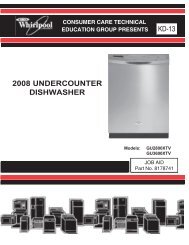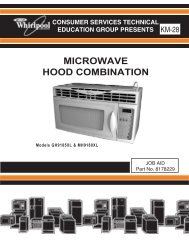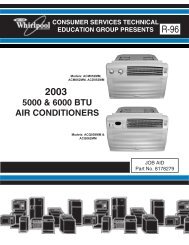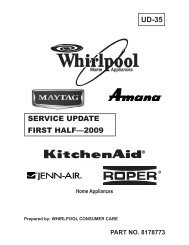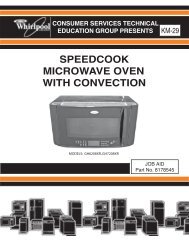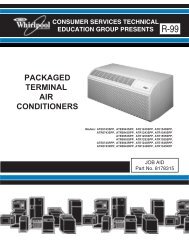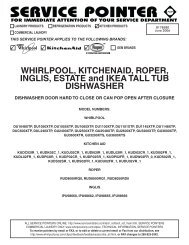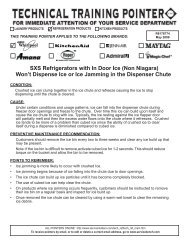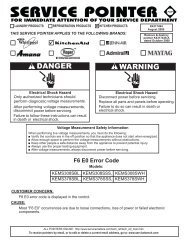UD-35 SERVICE UPDATE FIRST HALF—2009 - Whirlpool
UD-35 SERVICE UPDATE FIRST HALF—2009 - Whirlpool
UD-35 SERVICE UPDATE FIRST HALF—2009 - Whirlpool
You also want an ePaper? Increase the reach of your titles
YUMPU automatically turns print PDFs into web optimized ePapers that Google loves.
Original Large Reservoir<br />
Dispenser drip<br />
KABIR <strong>UPDATE</strong> -2009<br />
ICE AND WATER <strong>UPDATE</strong><br />
2327509<br />
Verify the 2327509 tank is installed. This is the smaller baffle tank. See figure 1.<br />
Verify the inlet and outlet is installed correctly from the reservoir tank. The correct<br />
inlet and outlet connections are Critical to ensure dispenser dripping is minimized.<br />
The 2314271 with 5/16” check valve has been helpful at both the door union (Tline<br />
models) and tapped into the line right after the reservoir outlet connection.<br />
Removing the ARD on the M line will help. Use regular ¼ tubing. You will need<br />
a bracket at the top in the dispenser to hold the tube. The water reservoir tank,<br />
2327509, has dramatically reduced our dispenser drip calls. Make sure the<br />
technicians are using this smaller baffle tank as a service part, not the larger<br />
baffle tank. The larger baffle tank does not improve dispenser drip as well as the<br />
2327509 tank does.<br />
39<br />
Inlet<br />
Figure 1<br />
ICE CUBES STICKING TOGETHER<br />
Infrequent Use<br />
Outlet<br />
Ice cubes will stick together over time. Customers that dispense ice infrequently<br />
(more than a week or so between dispensing) will notice this because it is normal.<br />
This is probably the most common cause of cube clumping complaints. Look for<br />
cubes which otherwise appear fairly normal (although over long periods of time some<br />
frost may build). Sublimation and melting occur at the molecular level even at temperatures<br />
which remain well below freezing. The water molecules condense and<br />
refreeze back on the cubes and this will cause cubes to freeze together at points of<br />
contact.<br />
The main points to take away from this are:<br />
Neither warm temperatures nor airflow are necessary for ice cubes to stick together.<br />
Over time, this will occur even at extremely cold temperatures. The cause is that<br />
molecules of water (ice) on adjacent cubes of ice join into the same ice crystal at the<br />
point of contact. The size and strength of the bonds grow with time. It begins happening<br />
immediately, but is at first too weak to notice. Use of the dispenser drives an<br />
auger motor which breaks up bonds, at least until they have grown too strong.



